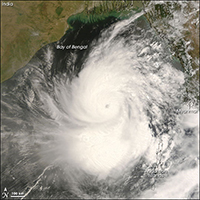Atmospher Sci & Global Chg
Research Highlights
July 2014
Tropical Tempests Take Encouragement from Environment
Scientists find 30-year trends in conditions that ripen Bay of Bengal tropical cyclones

In 2008, when Cyclone Nargis made landfall in Myanmar (formerly Burma), it caused large devastation. The second deadliest of all time, this Bay of Bengal cyclone was whipped up by environmental conditions favorable to tropical cyclones. Scientists are working to identify the environmental trends that favor such cyclones. Image courtesy of NASA Earth Observatory. Enlarge Image.
Results: Mix some warm ocean water with atmospheric instability and you might have a recipe for a cyclone. Scientists at Pacific Northwest National Laboratory and the Atlanta Oceanographic and Meteorological Laboratory found that the intensity of post-monsoon tropical cyclones in the Bay of Bengal has increased over the 30-year period from 1981-2010. The culprit? Trending increases in certain environmental conditions that brew up these storms: increased sea surface and upper ocean temperatures and atmospheric instability. These particular changes are prominent in the eastern Bay of Bengal where the strongest tropical cyclones have traditionally formed.
The research shows a consistent progression in these conditions, suggesting that the Bay of Bengal will be the location of increasingly intense post-monsoon cyclones.
Why It Matters: The Bay of Bengal, located in the Northern Indian Ocean, is marginally conducive to tropical cyclone formation. Tropical cyclones in the Bay of Bengal, however, have devastating consequences when they hit land due to a combination of factors such as a low-lying and flat coastal terrain, a shallow ocean floor, and a high population density of surrounding countries. For example, Tropical Cyclone Nargis in 2008 was responsible for the death of nearly 138,000 people in Burma (now Myanmar), and also affected Bangladesh, India and Sri Lanka. The environmental and societal toll makes it important to understand the future of tropical cyclone activity in this region.
Methods: While a few studies in the past investigated the influence of climate phenomena such as the El Niño Southern Oscillation and the Madden-Julian Oscillation on the inter-annual variability of tropical cyclones in the post-monsoon Bay of Bengal, changes in long-term cyclone activity are less well understood.
To attack this information gap, the research team analyzed 30 years of tropical cyclone track data obtained from the U.S. Navy's Joint Typhoon Warning Center. Also, they used sea surface temperature observation data from Britain's weather and climate data organization, the UK Met Office's Hadley Center and the National Oceanographic and Atmospheric Administration (NOAA), ocean reanalysis data from the Geophysical Fluid Dynamics Laboratory at NOAA, and atmospheric reanalysis data from the European Centre for Medium-Range Weather Forecasting and NOAA's National Centers for Environmental Prediction for that 30-year period.
They found increases in sea surface temperature and upper ocean heat content made the ocean more conducive to tropical cyclone intensification, while enhanced convective instability made the atmosphere more favorable for the growth of these storms.
What's Next? Scientists are working to understand the large-scale climatic conditions responsible for the observed changes in the various environmental parameters controlling tropical cyclone development.
Acknowledgments
Sponsor: This research was supported by the U.S. Department of Energy, Office of Science, Office of Biological and Environmental Research as part of the Regional & Global Climate Modeling program.
Research Team: Karthik Balaguru, Sourav Taraphdar, and L. Ruby Leung of PNNL; Gregory R. Foltz of Atlanta Oceanographic and Meteorological Laboratory
Research Area: Climate & Earth Systems Science
Reference: Balaguru K, S Taraphdar, LR Leung, and GR Foltz. 2014. "Increase in the Intensity of Postmonsoon Bay of Bengal Tropical Cyclones." Geophysical Research Letters 41(10):3594-3601. DOI:10.1002/2014GL060197.
